Cruziohyla craspedopus, the fringed leaf frog or fringed tree frog, is a species of frog in the subfamily Phyllomedusinae. It is found in the Amazonian lowlands in Brazil, Colombia, Ecuador, and Peru, and possibly in Bolivia.

Agalychnis psilopygion is a species of frog in the subfamily Phyllomedusinae. It is found in southern Colombia and north-western Ecuador. It has been observed between 100 and 500 meters above sea level.
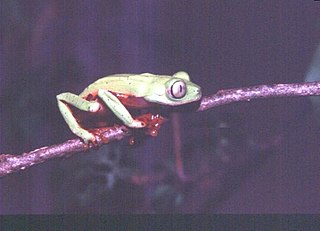
Phasmahyla cochranae, sometimes called the chocolatefoot leaf frog, is a species of frog in the subfamily Phyllomedusinae. It is endemic to Brazil. People have seen it between 800 and 1600 meters above sea level.
Phasmahyla exilis, the mottled leaf frog, is a species of frog in the subfamily Phyllomedusinae. It is endemic to Brazil. It has been observed between 200 and 900 meters above sea level.
Phasmahyla jandaia is a species of frog in the subfamily Phyllomedusinae. It is endemic to Brazil, where it has only been observed more than 1000 meters above sea level.
Phrynomedusa appendiculata, the Santa Catarina leaf frog, is a species of frog in the subfamily Phyllomedusinae. It is endemic to Brazil, where it is only known from the southern Atlantic Forest.
Phrynomedusa bokermanni, Bokermann's leaf frog, is a species of frog in the subfamily Phyllomedusinae. It is endemic to Brazil.
Pithecopus ayeaye, also known as the reticulated leaf frog and reticulate leaf frog, is a species of frog in the subfamily Phyllomedusinae. It is endemic to Brazil. P. ayeaye is found in the transition zone between cerrado and Atlantic semi-deciduous forest, laying its eggs on leaves above streams or pools so the tadpoles, when hatched, fall into the water below. This species is under threat from habitat loss resulting from mining activity and fires, and is also affected by pollution from mining and pesticides. Its restricted range is likely to make it particularly vulnerable to these threats.
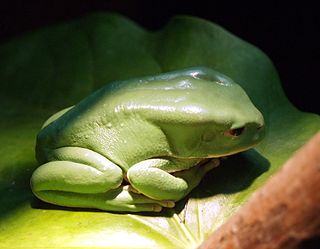
Phyllomedusa boliviana is a species of frog in the subfamily Phyllomedusinae. It is found in Argentina, Bolivia, and Brazil. It has been observed between 200 and 1800 meters above sea level.

Phyllomedusa camba or the black-eyed monkey frog is a species of frog in the subfamily Phyllomedusinae. It is found in Bolivia, Brazil, and Peru. It has been observed between 280 and 1000 meters above sea level.

Phyllomedusa distincta is a species of frog in the subfamily Phyllomedusinae, endemic to Brazil. It has been observed as high as 1000 meters above sea level.
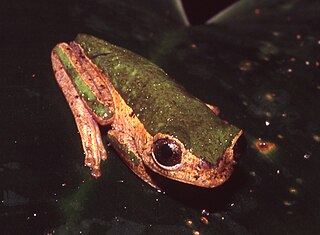
Pithecopus palliatus is a species of frog in the subfamily Phyllomedusinae. It is found in Bolivia, Brazil, Ecuador, Peru, and possibly Colombia. Its natural habitats are subtropical or tropical moist lowland forests and intermittent freshwater marshes. It is threatened by habitat loss. It has been observed between 100 and 400 meters above sea level.
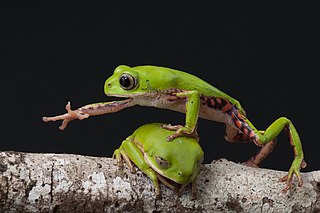
Pithecopus rohdei, also known as Rohde's leaf frog, Rohde's frog, and Mertens' leaf frog, is a species of frog in the subfamily Phyllomedusinae. The species was previously placed in the genus Phyllomedusa. The species is endemic to southeastern Brazil and occurs at elevations up to 1000 meters above sea level.

Phasmahyla spectabilis is a species of frog in the subfamily Phyllomedusinae. It is endemic to Brazil and known from the north-eastern Minas Gerais and adjacent southern Bahia. It occurs in fragments of Atlantic Forest at elevations of about 800 m (2,600 ft) above sea level.People have seen it as high as 850 meters above sea level.
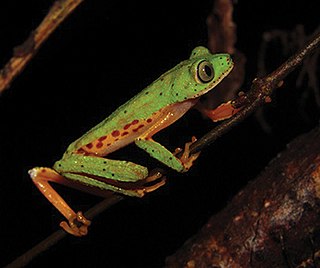
Phasmahyla timbo is a species of frog in the subfamily Phyllomedusinae. It is endemic to Brazil. Scientists know it exclusively from Serra do Timbó. People have seen it between 800 and 900 meters above sea level.

Polypedates braueri is a species of frog in the family Rhacophoridae. It is endemic to Taiwan. It has also been introduced to Guam. It has been observed between 0 and 2200 meters above sea level.
Phasmahyla cruzi is a species of frog in the subfamily Phyllomedusinae. It is endemic to Brazil and solely known from the vicinity of its type locality, Rio das Pedras Reserve in the municipality of Mangaratiba, Rio de Janeiro state. The range extends into the adjacent Paraty municipality. This species is named for Carlos Alberto Gonçalves da Cruz, Brazilian herpetologist. The common name Mangaratiba tree frog has been proposed for it.
Phasmahyla lisbella is a species of treefrog in the subfamily Phyllomedusinae, endemic to Brazil. Scientists know it only from the type locality: Fazenda Ventania in Área de Protecão Ambiental Ventania. It has been observed between 536 and 1,000 meters above sea level.
Phyllomedusa neildi is a species of frog in the family Hylidae endemic to Venezuela. Scientists know this frog solely from its type locality: Sierra de San Luís. This frog has been observed between 550 and 1150 meters above sea level.
Phyllomedusa chaparroi is a species of treefrog in the subfamily Phyllomedusinae endemic to Peru. Scientists have only seen it in two places. This frog has been observed between 537 and 650 meters above sea level.










